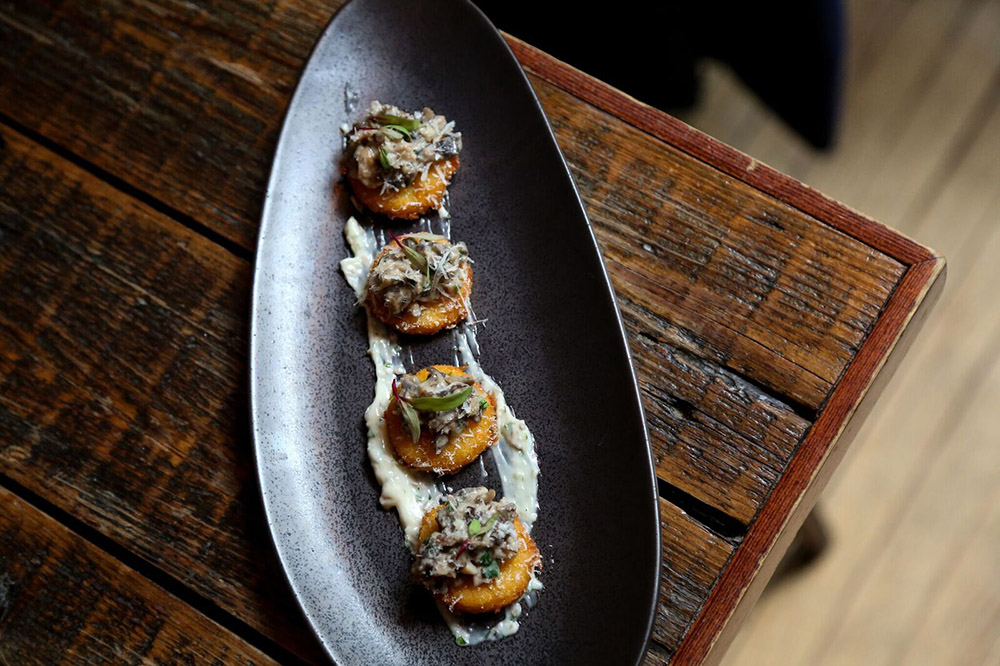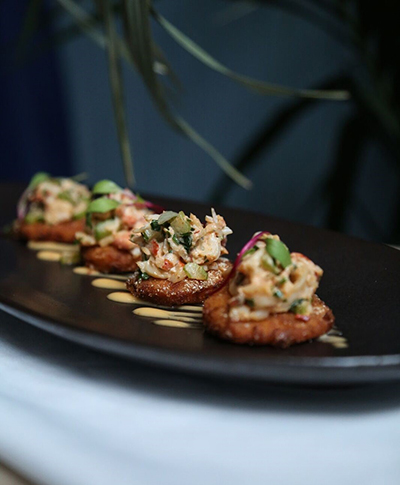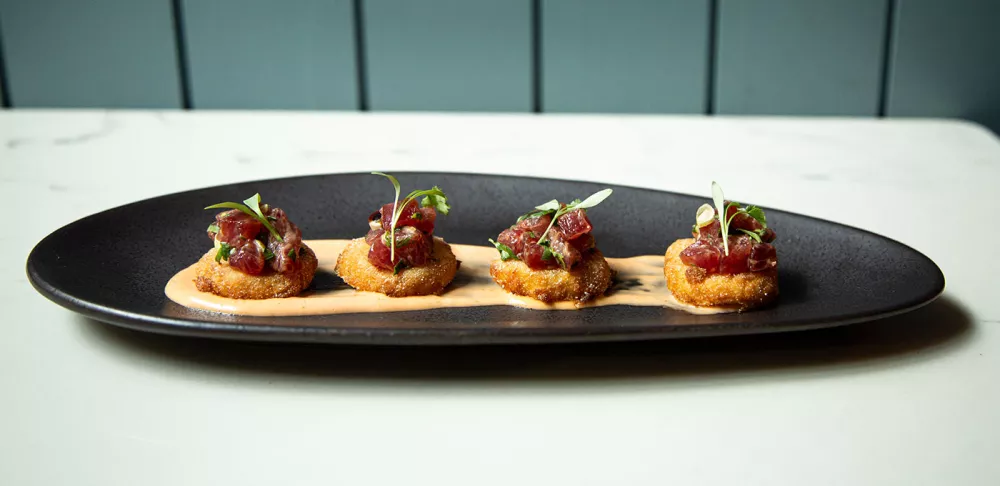The best thing about my arepas is that they’re not your typical arepas. Traditionally you have Colombian and Venezuelan versions: Colombian has a little piece of cheese on top and Venezuelan is stuffed. I put everything on top. Mine are a combination of both and add secret ingredients to change the texture. All arepas have corn flour and water and are cooked on a griddle or sauteed. Mine are fried.
The first time I created an arepa was in 2014 before I opened my first Latin restaurant, Blend on the Water in Long Island City, Queens. People came to the restaurant for the views and enjoyed the food. Blend was the first restaurant where I could make Latin food, and I was excited to fuse the French, Italian and American techniques I had learned with Latin flavors.
I went to one of the number one arepa bars, Caracas Arepa Bar downtown, and there was a line out the door. I waited an hour and a half to sit down in this small restaurant and when I finally had it, it was good, but my goal was texture. I thought, how can I make this different, better and unique? I played around with the recipe for six months. At first it was a sope (Mexico’s fried corn tortilla bite) made out of corn and fried, but the texture was a little off. So my goal was to fry an arepa so it’d be crispy on the outside, moist on the inside, and I wanted to layer flavors with sauces and toppings. I wanted it to be true to my fine-dining experience and an upscale bite.
The first version combined braised chicken, slices of avocado and a cilantro sauce. It needed work: It was good, but it wasn’t great. I tested it out on friends and family who came to the restaurant and decided to merge French cuisine by using a braised beef short rib. The first official arepa for the public was topped with braised beef short rib, guacamole, pico de gallo, cojita cheese, a lime-scented sour cream and micro cilantro. That was the first time I took a bite and was blown away. It was special.
I got excited every time someone new tried it and needed another one. Since it was a brand-new restaurant, I used the dish as my “compliments of the chef” to welcome people to Blend on the Water. People were making reservations just to have that arepa. They offered money for the recipe. I put it on the menu after three months and it was our No. 1 seller.

The arepas were a big hit, and I didn’t like the fact that we were just taking the short rib off for vegetarians. They’re already gluten-free, and I wanted the next version to be vegetarian. Forbes’ 30 under 30 club hosts a food competition every year and my first time participating, the judge was Daniel Boulud. I decided to make something vegetarian that would blow people’s minds and appeal to Chef Daniel. I served a black truffle mushroom arepa with a truffle aioli and a mushroom duxelle, which is a classic French accompaniment, usually with beef Wellington. I sauteed mushrooms with garlic and herbs, chopped, cooked, reduced with heavy cream, added parsley and finished with butter and truffles. I got beautiful layers of texture and flavors.
Chef Daniel was very impressed that he tasted something that was Latin and French at the same time — and he wanted extra truffles. He announced my victory that year, which was special because Chef Daniel selected me for my C-CAP scholarship when I was 15-years-old and awarded me a trip to France when I was 30. It was great to duplicate a photo with him 15 years later.
I’ve won the Forbes 30 under 30 food fight for four consecutive years: reigning, defending, undefeated crowd’s choice champion. I think I’m going to retire next year, and now my team is excited. We have no idea what the finale arepa will be, but I have 10 months to perfect it.

Now I create new arepa variations for new events. The more I do, the more I become known for arepas, and you have to give the people what they want. We serve five at my rum bar, Las’ Lap: tuna tartar, a new crowd favorite with sweet soy sauce and sriracha aioli; a lobster roll arepa with sweet chili aioli; and my favorite, pollo guisado — it hugs you when you eat it. That’s a Dominican chicken stew topped with pickled red onions, melted mozzarella cheese, a slice of avocado, and I finally used the cilantro aioli from day one that made so much more sense with this one.
We make a new arepa for the bar every year, and that’s the fun part: figuring out how we take it to the next step. My team has been with me for nine years, they know what we’re looking for and I trust their palettes. We explore what other proteins can we put on top. I’ve tried chocolate to make a sweet arepa; I tried sugar and it was overwhelmingly sweet. Lamb didn’t work out, beef tartare didn’t convince people to eat raw beef. (The only way to get people to try new things is to not tell them what’s on it.)
There’s inspiration for the five kinds: Each one has to tell a story. And to me when I create a new one, there are reasons behind it. I want to make sure that every bite is unique, a flavor bomb that leaves you wanting more. That’s the tuna tartar now for me. It’s so addicting. The arepa’s warm, the tuna’s cold, there’s a slice of jalapeno. I can’t explain how great it is until you try it.
Now if I walk into a room, the first question I’m asked is if I have arepas like they’re in my back pocket. I’ve become the arepa man and that’s what happens when you beat Bobby Flay.
I mix my arepa dough with my hands. It has to feel a certain way. I have to roll it into a ball and see that it doesn’t fall apart. I experiment with water and fat until I achieve the right texture. A regular arepa batter will disintegrate in a fryer. I cook and puree fresh corn and then I add all of the ingredients. I’m not looking for my arepa to be Colombian or Venezuelan, it’s not traditional. If you have my arepa, you’ll never have it that way again. These are Chef Kelvin’s arepas.
Learn more about global cuisine in ICE's Culinary Arts program.




